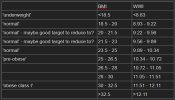s'nic
Well-Known Member
- Relationship to Diabetes
- At risk of diabetes
I only came across this today, has anyone looked into it in any depth?
I think most people are aware that BMI as a measurement is flawed. Waist to height ratio, while useful, is also a pretty blunt tool.
It seems the weight-adjusted waist index (WWI) incorporates "the strengths of waist circumference while dampening the connection with BMI"
Apparently it deals better with different body builds and different fat distribution. A greater WWI score indicates a higher level of obesity. For the calculation a calculator or spreadsheet equation is useful.
The WWI (cm/√kg) is calculated by dividing waist circumference (cm) by the square root of weight (kg)
I found it quite hard to search for info on this because the silly internet kept throwing world war 1 stuff at me for wwi, and "weight-adjusted waist index" tends to find quite specific medical publications.
I'm happy to post links, but not all quotes below were from the results summaries, some were from the full results or discussion of the results (I dug through a fair bit of c**p). Note that quotes are not provided for guidance or advice, but are purely examples from some research papers.
I started looking in relation to the liver, then followed a link for a ckd related paper, then looked for guidelines on what was a desirable wwi (or tried to)
"we determined that the WWI cut-off point used to identify NAFLD was 9.7675 in men and 9.9987 in women"
"comparison between groups suggested that participants with a WWI > 11.11 had higher rates of NAFLD and liver fibrosis"
"the prevalence of CKD considerably rose when WWI > 9.81 cm/kg"
"The optimal cutoff values of WWI for unhealthy body composition were 10.4 cm/√kg in men and 10.5 cm/√kg in women."
The link for that last one was https://onlinelibrary.wiley.com/doi/full/10.1002/jcsm.13302 dated august last year
I don't know about anyone else but an accurate waist measurement has foxed me for awhile as it varies if the tape measure is only a small amount higher or lower, and I wasn't certain exactly how high or low it should be, so I checked for the definitive waist measurement.
For an accurate waist measurement we should measure at the mid point between the bottom of the lowest rib & the top of hip bone (usually just above the belly button).
My WWI is 11.39, so I need to work on that!
I think most people are aware that BMI as a measurement is flawed. Waist to height ratio, while useful, is also a pretty blunt tool.
It seems the weight-adjusted waist index (WWI) incorporates "the strengths of waist circumference while dampening the connection with BMI"
Apparently it deals better with different body builds and different fat distribution. A greater WWI score indicates a higher level of obesity. For the calculation a calculator or spreadsheet equation is useful.
The WWI (cm/√kg) is calculated by dividing waist circumference (cm) by the square root of weight (kg)
I found it quite hard to search for info on this because the silly internet kept throwing world war 1 stuff at me for wwi, and "weight-adjusted waist index" tends to find quite specific medical publications.
I'm happy to post links, but not all quotes below were from the results summaries, some were from the full results or discussion of the results (I dug through a fair bit of c**p). Note that quotes are not provided for guidance or advice, but are purely examples from some research papers.
I started looking in relation to the liver, then followed a link for a ckd related paper, then looked for guidelines on what was a desirable wwi (or tried to)
"we determined that the WWI cut-off point used to identify NAFLD was 9.7675 in men and 9.9987 in women"
"comparison between groups suggested that participants with a WWI > 11.11 had higher rates of NAFLD and liver fibrosis"
"the prevalence of CKD considerably rose when WWI > 9.81 cm/kg"
"The optimal cutoff values of WWI for unhealthy body composition were 10.4 cm/√kg in men and 10.5 cm/√kg in women."
The link for that last one was https://onlinelibrary.wiley.com/doi/full/10.1002/jcsm.13302 dated august last year
I don't know about anyone else but an accurate waist measurement has foxed me for awhile as it varies if the tape measure is only a small amount higher or lower, and I wasn't certain exactly how high or low it should be, so I checked for the definitive waist measurement.
For an accurate waist measurement we should measure at the mid point between the bottom of the lowest rib & the top of hip bone (usually just above the belly button).
My WWI is 11.39, so I need to work on that!


